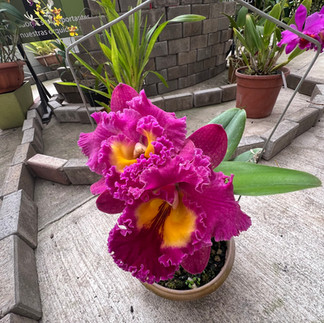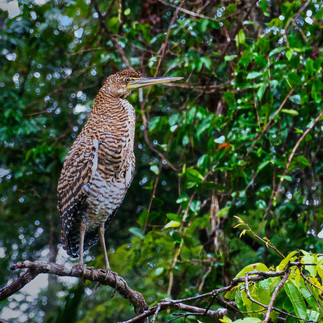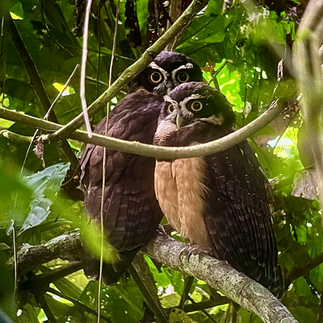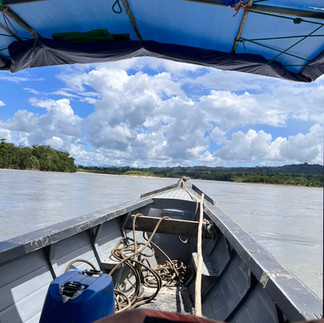Recap: 3 months of Travel in Central and South America
- Terrence

- Jun 6
- 18 min read
It was two years in the planning and we did it; we travelled through Central and South America and had the adventure of a lifetime. It was not without its up and downs, as you would expect, but we did it; and our marriage remains intact and strong after spending 24/7 together! (not that we expected otherwise)
We started our journey in Cozumel, Mexico and moved onto Costa Rica, Panama, Peru, Argentina, and then Chile. Our itinerary was firmly established (every day was booked with something) for the first two months but, when we got to Argentina and Chile, we decided to follow our noses. Up to now, our blog posts have been relatively short, focusing on highlights of each place we visited. The following is a lengthier account with some additional stories about our experiences of three months living out of a suitcase.
We started with two weeks of scuba diving in Cozumel, Mexico. This place is an old friend of ours as we have dived there for many years, and it never fails to impress. The Mexicans have done a great job of protecting the reef even though there is now pressure to construct additional cruise ship terminals. The reef is still relatively-unspoiled and vibrant. The joy of diving is not only the seeing the incredible underwater life and vistas, but also meeting like-minded people. During our two weeks in Cozumel, we made fast friends with the hotel owner and a fellow diver (Chris) who is a a kind-hearted, wonderful guy from San Francisco. We had several incredible dives together. The visibility was amazing and the underwater life did not disappoint. Thankfully, my underwater camera is digital and not film as I shot at least 1000 photos during our two weeks!
As a scuba diver, I highly recommend Cozumel. Although heavily visited and often busy with cruise ships, it is still exciting and continues to offer up activities we had not previously enjoyed. For instance, we met a fellow who started walking tours that visit key places in the downtown part of the island as well partaking in excellent local cuisine. If you are ever in Cozumel, look up Food Walking Tour with Julio…you won’t be disappointed.
Underwater, eagle rays and thriving populations of a variety of fish, lobsters, crabs, and corals kept us entertained day after day. Our stay at Blue Angel Resort was perfect for divers. It offered excellent food, early live music several days each week, and small dive groups. The staff were all friendly and extremely helpful.
Views from the ocean floor and from Blue Angel Resort
From Cozumel, we headed to Costa Rica. This was our third visit and the country was as fresh and exciting as the first time. Our time here included visiting friends, Mike and Michael, a couple that we had met after we rented their AIrBnB on a previous visit. This time, we were lucky enough to be able to rent their space again as their property is very popular and often fully booked. This beautiful spot is like a mini national park with a small river running through the property. As one could expect, the river attracted several varieties of birds. One of our favourites was a juvenile Tiger Heron who patiently perched on a river rock waiting for its fresh fish dinner.
During our stay in Costa Rica, we were treated to bucketloads of wildlife and had a wonderful visit to a local botanical garden started by a English botanist. Lankaster Botanical Garden is an eye-popping display of all types of beautiful plants. One of our favourite parts of the garden was the orchid house where orchids of every colour and shape imaginable were in bloom. I think we again put our cameras through their paces!
The orchid house at Lankaster Botanical Garden
To cap off our stay in Costa Rica, we went to an area on the east coast called Tortuguero. Our main objective was to experience the bird watching in the river delta. To get to Tortuguero, one has to catch a river taxi from a spot called La Pavona, an essential port with river boats that transport people to Tortuguero and back. The ride takes about an hour and there is a lot to see along the way. The river banks provided sites of herons, egrets, iguanas, and more.
Tortuguero is famous for nesting turtles that come in the thousands. There are four different varieties of turtle that lay their eggs in Tortoguero at different times of the year. Green turtles are the predominant species and arrive between July and October. Sadly, we saw a few skeletons along the beach. Jaguars may be elusive, but they are present and they take advantage of the turtle nesting times to grab an easy meal. It is unfortunate to see the remains of large turtles, but we must remember that it is nature at work.

Main Street, Tortuguero
We were pretty excited to go on a birding boat tour through the numerous “canals” of the river. We left very early in the morning, but when we arrived at the dock with our guide to check into the national park, the rain started to fall. It was a typical tropical downpour. Translated, this means it came down in buckets. Luckily, we were moored under a shelter and were able to keep dry while we waited for the storm to pass. Eventually, we made an attempt at boating through the delta and we did see a number of birds such as a Tiger Heron, a Little Blue Heron, and a Tri-coloured heron. We even saw a young crocodile lurking in the shallows but, the rain won the day and we had to cut our tour short. We had been taking turns bailing buckets of water out of the boat. This made securing our camera gear under rain jackets and ponchos difficult and we had to hide them more than we could use them. It was disappointing but you can’t tell Mother Nature what to do.
Birds and Restaurants of Tortugero
After two weeks of dealing with heavy rains in Costa Rica, we headed to Panama. When we arrived in Panama City and were In the taxi on the way from the airport to our hotel, we were amazed to see Panamanian flags everywhere. Each guard rail post and lamppost was bedecked with flags. Our taxi driver could not tell us why there were so many flags on display and it was only after a few days that we realized it was in response to Donald Trump’s threats to take over the Panama Canal and the imminent visit by Marco Rubio. When we toured the canal, we passed the American embassy and saw all the green spaces around the embassy also filled with flags. Panama was certainly signalling its national pride.
Panama City has a lot to offer a tourist. Some of the highlights for us were a visit to to the Bio-museum, a splendid showcase for the natural and social history of Costa Rica. This is a highly recommended visit. Not only did we learn a lot about Panama, we were impressed that the architectural design of the building was created by a fellow Canadian, Frank Gehry.

Another worthwhile visit is to the remarkable 573-acre Metropolitan Natural Park right in the heart of Panama City. Despite being close to the city, the park is home to 227 bird species, 45 mammals including sloths, 36 kinds of snakes and 14 kinds of amphibians. In addition, there are about 284 plant species, including trees that reach between 100 and 115 feet high. Although it is possible to see all of these fabulous creatures, one should always keep in mind that it more likely they will remain hidden. Our philosophy is to always go with an open mind and hope for the best while remaining realistic.
Driving in Panama City is an experience all of its own. It seems there are only two necessary items on vehicles; namely the accelerator and the car horn. The street signs will tell you to use your "claxon" when navigating through narrow roadways which is absolutely accurate. The numerous, simultaneous horns blowing at any given time definitely sound like "claxon"! Honking means a lot of things like “let me into the lane,” “get out of the way,” or sometimes “I haven’t use the horn in ten minutes so I’m just trying it out to see if it still works!” Once you get used to it, it's less dauting and driving becomes easier in this massive city.
Panama City
When we left Panama City, we rented a car and drove about six hours to a small town called Pixvae. We stayed at the Ark Divers Resort whose specialty is diving in the Coiba National Park. We were excited to dive here as the area is very similar to the Galapagos in that there is an upwelling that creates ideal conditions for a lot of pelagic species. We were hoping to see both Mantas and Whale Sharks. Sadly, we only saw one Manta that was at a great distance away and we were a day late to see a whale shark; arghh!! The vagaries of nature struck again. To rub salt in the wound, hammer head sharks, more manta rays, and orcas have all been viewed since we left. As with the Metropolitan park, there is never a guarantee that you will see what you want to. However, our stay at the Ark Divers was extraordinary and our hosts were most definitely the hosts with the “mostest”. Audrey, the owner, cooked spectacular meals that could only be described as gourmet, and I’m proud to say she is Canadian too.
Pixvae
After a week in Pixvae, we drove to an area called Anton de Valle. This area is an ancient volcano caldera and is one of the larges inhabited calderas in the world. Our Stay here was in an Airbnb high on the slopes with a balcony facing the forest where we spent all morning sipping coffee and eating treats while photographing all manner of exotic birds. The week-long stay here was sublime and was the perfect transition before we began our next adventure, a week-long birdwatching tour in the Darien Gap.
One of our biggest hopes on this tour was to see the Harpy Eagle. For those who aren’t familiar with this eagle, it is one of the world's largest and feeds on monkeys and sloths; a formidable raptor. Our stay in the Canopy Camp was in a safari-style tent with a private, adjacent bathroom…quite luxurious! There was no air conditioning, but we did have electricity and fans, making our stay very comfortable. Once again though, we were plagued by rain, and we were starting to think that we were cursed. However, I am glad to say it did not deter us but, it did make for muddy trail conditions and very hot, humid days. We were very lucky to find a Harpy Eagle sitting in a tree and the group spent a long time viewing it through the scope and taking photos. And, yes, it was as great as we thought it would be!
Some highlights of Canopy Camp were the amazing variety of hummingbirds in the campsite. We were able to watch them for long periods of time at the common area. We also had delicious, home-cooked meals prepared for us. The daily excursions were strenuous with one particular day’s plan to see the Crested Eagle (the second largest eagle in Panama). This hike was described to us by other people staying at the camp as a “death march” and they warned us of the steep, muddy inclines in the heat and humidity. Our guide simply told us that we would start the hike on flat ground and then there would be some ups and downs. It was actually mostly up in hot temperatures and high humidity, making our fellow campers’ description more accurate. The hike was led by local indigenous people called the Embera. We hiked, were transported across rivers by horse, and trudged through mud and bush for 3 hours. Once at the site, the Embera, who are experts at finding the eagle’s nest, treated us to a wonderful sight of the female standing guard close to her nest while waiting for her mate to feed her. We had missed the feed at an earlier time when he brought her a squirrel, but the Embara elder showed a photo that he had taken on another day.
Welcome sign at Embera village, Hummingbird at Canopy Camp, Spectacled Owls
Our guide, Oscar, had a encyclopaedic knowledge of birds and their sounds. We saw (and heard) many varieties and came away with another large batch of photos.
Peru was the next country on our itinerary. We started with a two-night stay in Lima. We had a bit of a shock when we checked into our hotel. It was in an area that seemed, shall we say, quite shady. The booking we made had photos of a beautiful hotel but the reality was somewhat different. How many times have we (or you, for that matter) booked a hotel or BnB only to find the actual lodgings weren’t quite as advertised? The staff were wonderful but the place was not very clean and our feet were dirty from walking on the floor. The funny thing was that this was the executive suite which came complete with a 70’s style jacuzzi with a broken tub skirt and plastic heart stickers on the bathroom mirror. It was not as expected, but we had to laugh.
Anyway, Lima is a great city, and it was easy to get around with Uber. We rested up, got sim cards for our phones and did some touring around our part of the city. Most importantly, we took two weeks of laundry to a local laundry shop. I have to tell you that the clothes we wore in our jungle expeditions really needed a cleaning. LOL!
From Lima, we flew to Cusco to begin our next adventures. What a shock it was to be confronted by high altitude. Cusco is at about 3500 metres or 12500 feet. It was hard to breathe and the feeling of not getting enough air never left me while we were there. Some nights, going to sleep at altitude felt like having a heart attack with tightness in our chests.
We spent our first week in Cusco touring the surrounding areas and going to one of my bucket list places, Macchu Pichu. Unfortunately, altitude sickness affected me and I could not complete the tour. But, I was there and was able to see the amazing the site. Susanne’s photos of the Condor Temple helped me feel a bit better but I would have rather seen it with my own eyes.

The next part of our stay in Peru had us leaving Cusco for Manu National Park, staying in bush camps. The shelters were rustic but we did have on-suite bathrooms . However, they only had cold water showers. Let me just say that when you are sweaty and stinking hot, getting into a cold shower is not invigorating, but downright unpleasant. It was not quite what we were expecting but, on the good side, we were the only ones on our tour and we had a private cook, driver and guide. Our guide, Michel, was a fountain of knowledge and found many birds for us such as toucanettes and parrots. Unfortunately, we did not see the one we really wanted which was the Resplendent Quetzal. How frustrating! As stated previously, that is nature.
Our stay in Peru was quite the adventure from seeing amazing Incan holy sites, beautiful landscapes, and gorgeous colourful birds. Some of the jungle hikes we did were very challenging for us and, had we known beforehand, we might have not done them. However, in hindsight, what a blast! Our one bush camp required us to go on a river boat for 45 minutes and then clamber up a steep river bank followed by a 20 minute hike to our camp on a muddy and sometimes flooded trail. That same day, we set out on another adventure. We left camp, made our way back to the river and went upstream for about 20 minutes. From there, we hiked across the old river channel and into the jungle for over an hour to see a bird sanctuary that was cared for by local people. We saw many interesting birds including the Donkey Bird and Hoatzin but we stayed too long and ended up having to hike back to the boat in the dark. Did I mention we were in the jungle? Snakes, jaguars and other critters were a concern and we were very motivated to get back. Susanne had the added bonus of getting bitten by chiggers at the camp and her ankles were extremely itchy with blisters. No medicinal remedies helped and she had to just let time do its magic. Michel laughed it off and said she was lucky and was taking a bit of the jungle with her. She did not think it was very funny, but we agree that, when traveling, you must take the good with the bad.
Donkey Bird, View on Rio Madre de Dios, Hiking to camp
Peru gave us an amazing experience. Were able to see pre-Columbian and Incan structures and learn about Incan beliefs. We learned about the effects of Spanish colonization and the loss of Incan culture. Present-day Peruvians talk openly about how their ancestral way of life was lost and they like to share knowledge about their country. After spending several days looking at and walking among Inca structures, we now have a great understanding of this magnificent culture and of their ability to construct huge buildings in areas that should be thought of as inaccessible. It is truly a remarkable place.
Our scheduled tours were at their end and we moved on to Buenos Aires on a date that was specifically planned to coincide with Carnival. “Spoiler Alert:” we discovered that Carnival in Buenos Aires was pretty much non-existent. We could not find any festivities but what we did find is that the city was largely shut down for four days over the holiday. This included not restocking the ATMs with cash. Thankfully, credit cards are accepted almost everywhere.
As with much of our holiday thus far, non-stop rain played a starring role. We were often soaked as we walked through the Recoleta neighbourhood. One night, as we were walking to a restaurant for dinner, the skies opened up. When we arrived, we had to wring our clothes out before entering. Despite our efforts, we still left puddles of water on the floor!
El Ateneo Grand Splendid, Buenos Aires in the Rain
This was my second visit to the city and I was shocked at the amount of tourists. I could not believe how many of the sites I had visited before now had admission charges and were frankly overrun by tourists. I think though this is world-wide phenomenon now.
One of these locations was the Recoleta Cemetery which has many Buenos Aires' elites buried there in ornate mausoleums, including Eva Peron.
On a whim, we went to the Art Museum and were amazed at the free admission and the large collection of priceless art, including several Rodin statues. Visiting this museum is a highly recommended visit for anyone. There was a line-up to get in but that was due to access priorities being given to seniors and families with small children as well as encouraging people to make a donation at kiosks inside the doorway. We happily donated the recommended $5 as the price would have been far more expensive in north America to see similar art.
Mendoza was our next destination. Being the Wine Capital of Argentina, we enjoyed more than a couple of great wines. We savoured a multi-course lunch at a vineyard with paired wines, and had a wonderful dining experience. We also signed up for a half-day wine tour, visiting two wineries and an olive oil plantation. During the tour, the guide explained that we were lucky enough to be in Mendoza during the Harvest Festival, which was headlined by a parade though the town. She went on to describe how the people on the floats would throw produce into the crowds and that some of the fruit included melons and watermelons to which she added, “Peligroso, no?” meaning, "Dangerous right?" Our curiosity was piqued and we subsequently made plans to see this spectacle. True to much of our South American experience, there was very little English language information available to us when we tried to find out the time and route of the parade. We just followed our noses and finally found a street that was cordoned off and lined with police officers. We secured a restaurant table at the roadside and paid a cover charge. After ordering a bottle of wine, we had to sit for three hours before the parade started, by which time there were thousands of spectators crowding the street. Devout parishioners carring a large statue of the Virigin Mary were at the head of the parade followed by marshals on horseback. There were semi-trucks with huge generators being pulled to power the many loudspeakers and flood lights on each float. Astonishingly, the crowds went right up to the moving vehicles holding poles with baskets attached as they tried to catch canteloupes and any other fruits or vegetables being thrown from the floats. North American style safety protocols were not existent and we were surprised that nobody was hurt.
City of Mendoza, Start of Harvest Festival Parade, Wine aging in bottles
Mendoza has beautiful pedestrian-friendly, tree-lined streets. There is a lot al fresco dining in the pedestrian malls. A bit of annoyance though, was the multitude of street vendors selling everything from bubble gum to jewellery to socks and everything in-between. They approach anyone sitting at an outdoor cafe, one after the next. Thankfully, they move on if you say no thank you.
We rented a car for the day and went through a few mountain passes in the Andes. We marvelled at the changing landscapes, especially at Aconcagua, one of the world’s most treacherous mountains. It is reported that several climbers die each year as they try to reach the summit due to rapidly changing weather. The wind was outrageous with very strong gusts the day we went. So, we only took the short walk to the lookout to view the mountain and its high glaciers from afar before making our four-hour drive back to Mendoza.
Aconcagua in the distance, colourful section of the Andes, Inca Bridge
Our final stop in our incredible journey was Chile. We started in Punta Arenas, the southernmost city on the continental Americas. Ushuaia is further south, but it is on an island. Punta Arenas is famous for being the starting point of Shackleton’s famed Antarctic expedition. While here, we managed to achieve a bucket list item to see a King Penguin colony by joining a guided tour that took us to Tierra del Fuego, where the colony was located. The tour to the colony was an agonizing 16-hour endurance made worse by having to time the trip with the sparse ferry schedule. The colony is unusual in that it is on land, unlike most colonies which are on the Antarctic shelf. Upon arrival, we braved the icy 6 degree Centigrade wind and spent an hour just enjoying watching the penguins. To top it off, we also saw one small penguin. This penguin was a mystery to the parks people as it was a New Zealand penguin (they named him Hugo) and was very far away from his home.
We saw many things while staying in Punta Arenas. We visited the Museo Salesiano Maggiorino Borgatello which highlighted the anthropology and history of the area on four floors, each with its own theme. We also did a hike in Magellanes National Reserve. Amazingly, this reserve is on the outskirts of the city and was easy to access via a short taxi ride. We were treated by the park rangers to a viewing of two short eared owls a short distance away from the park entrance.

Punta Arenas is a very walkable city. One thing not to be missed is to sytroll along the seaside promenade which is punctuated by numerous great statues and several large flocks of birds. We saw two huge colonies of royal Cormorants; these are large birds that look like penguins but they can fly. Other highlights for us was renting a car and driving to Torres del Paine, a full day of driving but so worth seeing the rugged scenery and intact glaciers.
After a full week in southern Chile, we flew to our last stop, Santiago. We chose Santiago for our final week as we had finally managed to find flights to Canada, a surprisingly difficult task. We had no specific goal or place to see but were just happy to experience the city. We stayed right downtown in what is known as the tourist zone.
A lot of our time in Santiago was walking and finding interesting places to see and/or visit. Some of these were the beautiful National Library and the central square called Plaza de Armas. There was a big band playing hit tunes, a chess club with about 50 members playing chess and numbers of buskers with amazing talents. To top it off, there were a couple of evangelists sporting their own bullhorn preaching to passersby and a handful of followers. Truly a centre piece of Santiago. Later we read an article on the square that included a description of the local ladies who plied their trade in the square.
Walking around Providencia, Santiago de Chile
We managed to view the changing of the guard at the Presidential Palace which was quite the spectacle with marching bands, horse troops, and much pomp and ceremony. It was hilariously punctuated by a stray dog chasing his tail to the beat of the music.
Sadly, our tour ended with some unpleasantness as we tried to make our connecting flight in Dallas. Due to the Delta Airline online ticket booking that had automatically recognized us as previous passengers, Susanne’s former surname was put on the ticket. The agent in Santiago said that he could not change it but that it would not be a problem because it was obvious that the photos and birthdate matched on all of her pieces of identification. Unfortunately, the TSA agent in Dallas did not agree and he threatened to not allow her to make the connecting flight. He was adamant that she go back to the airline counter at the entrance of the airport to have it changed and told her that she should have come earlier to avoid missing her flight (an impossible task condering we were on a connecting overnight flight, not to mention that the customs agent already let her in the country). I have to give her credit for not losing her temper throughout this odd conversation. The TSA agent told her she had to tell me that she was not going to make the flight. When she asked if she could go over and talk to me, he said no. When she asked if she could text me, he said cell phone were not permitted in the security section. It seemed like an impossible situation and she told me later that she was already mentally planning a first class ticket home when it was all sorted out. Thankfully, another agent asked if he could help and advised to do a biometric scan. Once this was done, her identity was confirmed and she was finally allowed to go through security. We made it to our gate with only 20 minutes to spare before boarding our connecting flight. We prefer not to go through the United States most of the time due to long lines and wait times but, sometimes, it is unavoidable. We were tired but very grateful that we made back to Canada, and in time for our son’s birthday. We now have to sort through thousands of photos and begin planning our next adventure.
Cozumel, Costa Rica, Panama, Peru, Buenos Aires, and Mendoza




















































































Comments